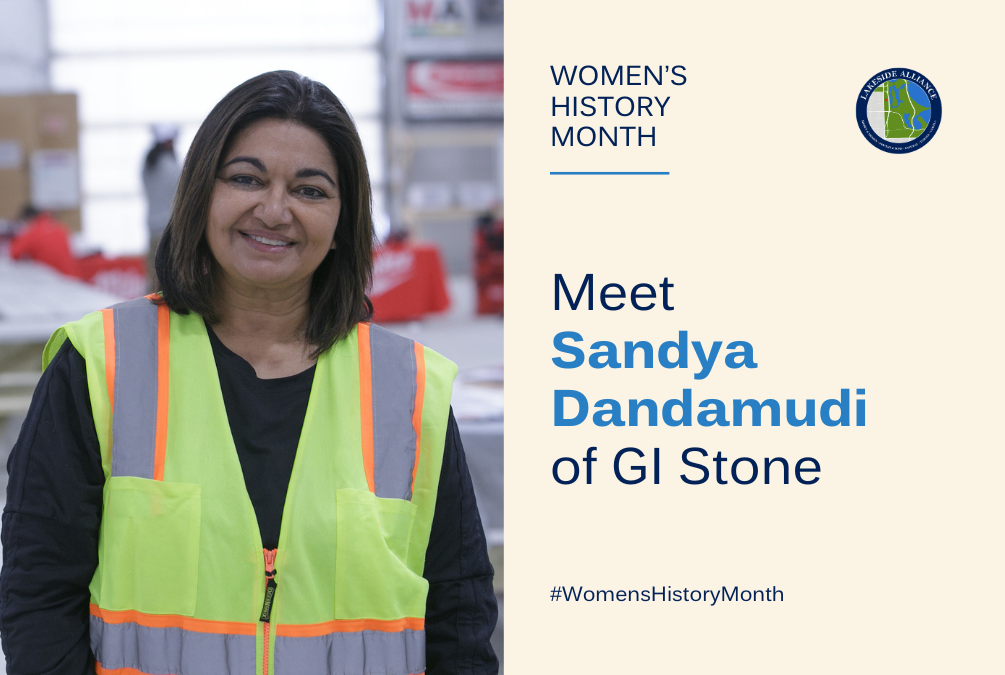Meet Sandya Dandamudi of GI Stone
When GI Stone was awarded work on the Obama Presidential Center, Sandya Dandamudi knew it would be her “swan song,” an especially meaningful project to round out her unexpected journey in construction. Years before, she never anticipated that she would someday work alongside her mother, Rani Dandamudi, an interior designer and the founder of GI Stone. With a bachelor’s degree in biochemistry and a graduate degree in ethnography, Sandya had a previous career in marketing before realizing that stone presented the perfect opportunity to combine her analytical strength with her eye for aesthetics.
What once was a small business trying to make payroll has become one of the biggest employers in their union, but Sandya still loves walking job sites to watch projects transform, solve problems and collaborate with her team. GI Stone was awarded all interior stone for the Obama Presidential Center project — tens of thousands of square feet.
For Women’s History Month, Lakeside Alliance spoke with Sandya about how GI Stone is preparing for installation, her legacy as a second-generation woman owner in construction and more:
What work has GI Stone performed so far?
A project of this magnitude demands an especially high level of oversight and rigorous approvals. We want this building to be there for a couple hundred years! The flooring is approved, purchased, fabricated and waiting in storage in Quebec. The walls are being fabricated. We still have some work to do on the bathroom stone, though we have some reserved in Vermont that we’ll soon go and inspect with the architect. Overall, we’re pretty far along with ordering, and looking forward to getting workforce on-site for installation.
What does it mean to you personally to participate in this project, and what does it mean for your business?
Thinking about who he is and what he stands for, President Obama is an incredible inspiration. My parents come from a small village in India and the whole village feels like this is their library, too. For the business, this project is distinct from the hospitality and high rise projects we are accustomed to and I know it means a lot to the team. Everyone feels a certain sense of responsibility. When you talk about DEI, we live it. We sponsored the first woman stone mason, and we’re committed to putting in more apprentices. Everyone on our team comes from a different walk of life. We truly see diversity work because we have diversity of thought.
As a Chicagoan, what is your greatest hope for the outcome of the Center?
That it serves as a beacon of hope. I am the vice chair of the DuSable Museum, so I spend a lot of time in the neighborhood. I love Chicago. The Obamas choosing this location is the best thing they could have done. I hope it helps rejuvenate the South Side, bring the city together and transform the area. Everyone on my team has been so touched by this project.
It’s not often that we speak to second generation women-owned businesses. What does that legacy mean to you?
Admittedly, in the beginning, it meant nothing. I grew up at a time when we were taught to be blind to identity, though I’ve now realized that I am in a position where I can inspire people, and that’s a huge responsibility. I want people to see me and see what we’ve done with this business. When I first started, there were no women in the industry. Today, I see women everywhere. The pieces of stone we’re working with for the Center weigh thousands of pounds each, so we have to rely on machinery to lift it. Anyone can learn to operate it and I want to see more women get into these trades.
What would you say to women who are considering a career in the construction industry?
You can do anything in construction! There are so many options. I encourage women to look at the whole field and decide what best suits their lifestyle. For those who are considering joining a trade, know that there are organizations out there offering pre-training and all kinds of support. Today, we’re fortunate as women because we can find mentors and sponsors. What I love about the industry is it can feel like belonging to a pack. You have 200 people on the jobsite, and once you are admitted, you are in. I think our own limitations are often ourselves.
“I want people to see me and see what we’ve done with this business. When I first started, there were no women in the industry. Today, I see women everywhere.”

